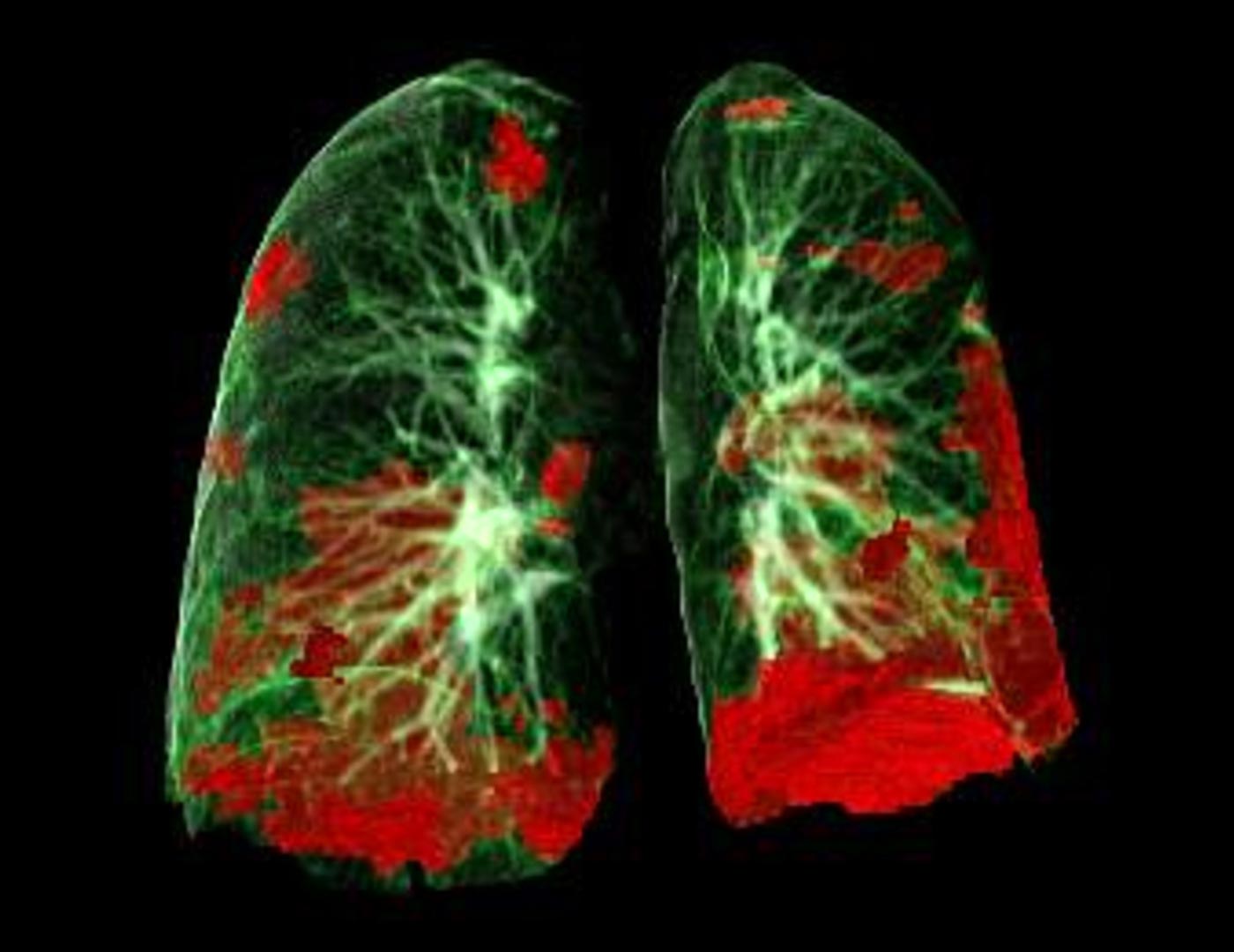CT scan of patient’s lungs shows COVID-19 damage in red. Photo credits: Gerlig Widmann and team, Department of Radiology, Innsbruck Medical University
Answers to the COVID-19 pandemic caused by the novel coronavirus, SARS-CoV-2requires models that can duplicate disease evolution in humans, identify potential targets, and enable drug testing. In particular, access to primary in vitro model systems of the human lung is a priority, as a large number of respiratory epithelial cells are the proposed targets for virus entry.
A team of infectious disease, pulmonary and regenerative medicine researchers at Boston University who are studying lung cells derived from human stem cells called type 2 pneumocytes that are infected with SARS-CoV-2 have now shown that the virus is initially the ability of the lung cells to suppress the immune system’s help with interferons to fight off the viral invaders and instead activate a pathway of inflammation called NFkB. “The infected lung cells release inflammatory proteins. In the body of an infected person, these proteins lead to inflammation in the lungs, ”explains the author Dr. med. Darrell Kotton, David C. Seldin Professor of Medicine at BUSM and Director of the BU / BMC Center for Regenerative Medicine (CReM).
According to the researchers, the inflammatory signals generated by the infected pneumocytes draw an army of immune cells into lung tissue loaded with infected and already dead and dying cells. “Our data confirm that SARS-CoV-2 prevents cells from activating one of the antiviral branches of the immune system early after the onset of infection. The signal that cells normally send out is a tiny protein called interferon, which they emit instead, causing them to be at risk of disease and delaying for several days, giving SARS-CoV-2 enough time to spread and kill cells, which causes dead cell debris and other inflammation build up, ”added Kotton.
The data is based on experiments carried out by the research team in the laboratory of co-senior author Elke Mühlberger, PhD, Associate Professor of Microbiology at BUSM and researcher at the BU’s National Emerging Infectious Diseases Laboratories (NEIDL). Kotton and other members of the CReM have developed sophisticated models of human lung tissue – three-dimensional structures of lung cells, called “lung organoids”, grown from human stem cells – which they used at the BU and in collaboration with other staff to study a Range of chronic and acute lung diseases.
The research team, led by first-time authors Jessie Huang (PhD), Kristy Abo (BA), Rhiannon Werder (PhD) and Adam Hume (PhD), adapted an experimental model that was previously used to study the effects of smoking cigarettes examine the coronavirus in the lungs tissues. Droplets of live coronavirus were then placed on the lung cells and infected them from the air in the same way that the virus infects cells that line the inside of the lungs when air containing the virus is breathed into the body. “This adaptation of human stem cell-derived pneumocytes to air, known as cell-fluid-interface cell culture, was an important advance that allowed us to simulate how SARS-CoV-2 penetrated deep into the lungs of the most severely affected cells invades patients, ”said co-senior author Andrew Wilson, associate professor of medicine at BUSM. “Type 2 pneumocytes are also infected and injured in patients with COVID-19, which makes this a clinically meaningful system for understanding how the disease injures the patient’s lungs.”
Wilson and Kotton are also pulmonologists and critical care physicians who care for patients with COVID-19 pneumonia at Boston Medical Center, while also running their laboratories to make the human lung cells that were then shipped to the NEIDL. There, Hume, a senior scientist in the Mühlberger laboratory, worked in a BSL-4 suit to carry out the infections of the cells, which the three cooperating teams then jointly analyzed using weekly zoom calls.
“These cells are an excellent platform to investigate the SARS-CoV-2 infection,” adds Mühlberger. “They likely reflect what is going on in the lung cells of COVID-19 patients. When you look at the damage SARS-CoV-2 is doing to these cells, you definitely don’t want to get the disease. ”
These results appear online in the journal Cell stem cell.
Reference: “SARS-CoV-2 infection of pluripotent stem cell-derived human lung alveolar type 2 cells triggers a rapid epithelial-intrinsic inflammatory response” by Jessie Huang, Adam J. Hume, Kristine M. Abo, Rhiannon B. Werder , Carlos Villacorta-Martin, Konstantinos-Dionysios Alysandratos, Mary Lou Beermann, Chantelle Simone-Roach, Jonathan Lindstrom-Vautrin, Judith Olejnik, Ellen L. Suder, Esther Bullitt, Anne Hinds, Arjun Sharma, Markus Bosmann, Ruobing Wang, Finn Hawkins , Eric J. Burks, Mohsan Saeed, Andrew A. Wilson, Elke Mühlberger and Darrell N. Kotton, September 18, 2020, Cell stem cell.
DOI: 10.1016 / y.stem.2020.09.013
Funding for this study came from the Evergrande MassCPR Awards, the National Institutes of Health, a CJ Martin Early Career Fellowship from the Australian National Health and Medical Research Council, an IM Rosenzweig Junior Investigator Award from the Pulmonary Fibrosis Foundation, and a Harry Shwachman Cystic Fibrosis Clinical Investigator Award, the Gilead Sciences Research Scholars Program, Gilda and Alfred Slifka and Gail and Adam Slifka, a grant from the Cystic Fibrosis Foundation and a Fast Grants Award.



